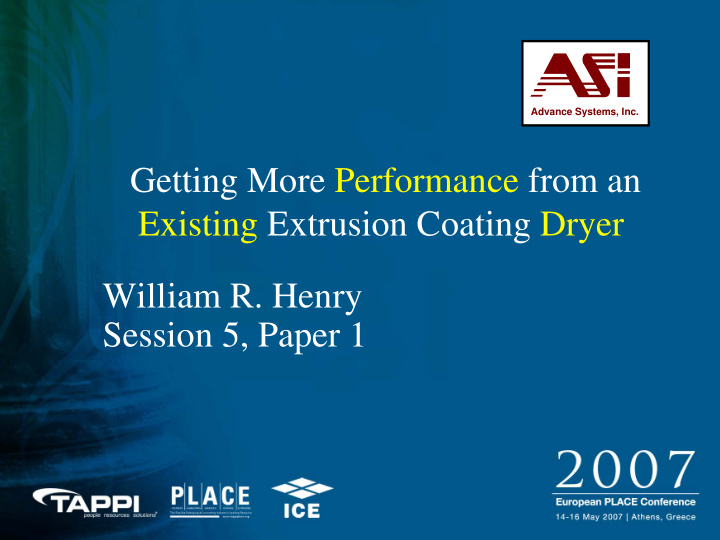



Advance Systems, Inc. Getting More Performance from an Existing Extrusion Coating Dryer William R. Henry Session 5, Paper 1
2
Getting More Performance from an Existing Extrusion Coating Dryer INCREASE LINE SPEED • • • • • • • • • INCREASE THROUGHPUT EFFICIENCY • • • • DECREASE ENERGY CONSUMPTION • • • • 3
• 2 zones, 96 O C,74 O C ZONE 2 ZONE 1 • Velocity = 1524 m/min • Length = 4.6 m • Line speed = 305 m/min • 11 microns, PP • A-131-X, 2.4% solids • 99% dry, 38 o C • EVAP Load = 595 MJ/hr 4
INCREASE LINE SPEED • Distribute drying load • Distribute Drying Load • Increase exhaust air • Use Drier air • Improve web stability • Increase air velocity • Increase air volume • Decrease nozzle-to-web gap • Decrease nozzle spacing • Pre-Heat web 5
ZONE 2 ZONE 2 ZONE 1 ZONE 1 74 o C 91 o C 96 o C 80 o C Zone 1 Zone 2 Total MJ/hr 96 C 74 C 595 80 C 91 C 594 6
INCREASE LINE SPEED • Distribute drying load • Increase exhaust air • Increase exhaust air • Use Drier air • Improve web stability • Increase air velocity • Increase air volume • Decrease nozzle-to-web gap • Decrease nozzle spacing • Pre-Heat web 7
• Increase exhaust air ZONE 2 ZONE 1 UNITS BASE MODIFIED exhaust rate 122 225 m 3 /min air temperature 96/74 96/74 o C energy usage 595 930 MJ/hr line speed 305 312 m/min 8 exit coating solids % 99 99
• Use dry make-up air ZONE 2 ZONE 1 UNITS BASE MODIFIED air humidity 0.015 0.012 kg/kg air temperature 96/74 96/74 o C energy usage 595 598 MJ/hr line speed 305 313 m/min 9 exit coating solids % 99 99
• Improve web stability Lateral movement of web may show at higher line speeds h o h o ~ k V 2/3 10
• Increase air velocity ZONE 2 ZONE 1 UNITS BASE MODIFIED air velocity 1524 1824 m/min air temperature 96/74 96/74 o C energy usage 595 688 MJ/hr line speed 305 335 m/min 11 exit coating solids % 99 99
• Increase air volume UNITS BASE MODIFIED nozzle slot width 3.18 4.76 mm air temperature 96/74 96/74 o C air volume 219 329 m 3 /min line speed 305 335 m/min 12 exit coating solids % 99 99
• Decrease nozzle-web gap ZONE 2 ZONE 1 Nozzle-to-web gap UNITS BASE MODIFIED nozzle-web gap 25.4 19.0 mm air temperature 96/74 96/74 o C energy usage 595 595 MJ/hr line speed 305 334 m/min 13 exit coating solids % 99 99
• Decrease nozzle spacing Nozzle spacing UNITS BASE MODIFIED nozzle spacing 17.8 12.7 cm air temperature 96/74 96/74 o C air volume 219 306 m 3 /min line speed 305 335 m/min 14 exit coating solids % 99 99
• Pre-heat web ZONE ZONE 2 1 infrared heaters UNITS BASE MODIFIED inlet web temp o C 21 32 air temperature 96/74 96/74 o C air volume 219 219 m 3 /min line speed 305 354 m/min 15 exit coating solids % 99 99
INCREASING THROUGHPUT EFFICIENCY • • • • 16
• Even temperature profile Uneven temperature distribution may indicate uneven heating or mixing of the air supply 17
• Even temperature profile Pull-thru Plenum Push-thru Plenum BURNER BURNER FAN FAN Hot Air Cooler Air Hot Air Cooler Air FROM Dryer FROM Dryer TO Dryer TO Dryer A “pull-thru” heat plenum will thoroughly mix the air 18
• Even temperature profile Static mixer Turning vanes 19
• Even velocity profile Like air temperature, the velocity profile has a direct bearing on heat transfer to the web 20
• Even velocity profile Distribution hole plates 21
• Even exhaust draw 22
• Reduce coating/web defects • spread out drying through entire dryer • achieve even drying across web width • maintain stable web to reduce edge damage or web breaks 23
24 DECREASING ENERGY CONSUMPTION • • • •
• Lower temperature – same speed UNITS BASE MODIFIED air velocity 1524 1676 m/min Nozzle-web gap 25.4 20.3 mm air humidity 0.015 0.008 kg/kg air temperature 96/74 82/60 o C energy usage 595 361 MJ/hr line speed 305 305 m/min exit coating solids % 99 99 25
• Avoid over drying Measure (IR sensor) and CONTROL the existing web temperature to ensure that the product is sufficiently dry but not TOO DRY. 26
• Insulate Prevent heat loss - ADDITIONAL insulation may be internal or external 27
• “Negative” dryer pressure Internal pressure inside the dryer enclosure should be slightly lower than the outside pressure. Excessive air flow INTO or OUT OF the dryer is a needless energy loss. 28
Getting More Performance from an Existing Extrusion Coating Dryer INCREASE LINE SPEED • • • • • • • • • INCREASE THROUGHPUT EFFICIENCY • • • • DECREASE ENERGY CONSUMPTION • • • • 29
Advance Systems, Inc. Getting More Performance from an Existing Extrusion Coating Dryer William R. Henry Session 5, Paper 1
Recommend
More recommend